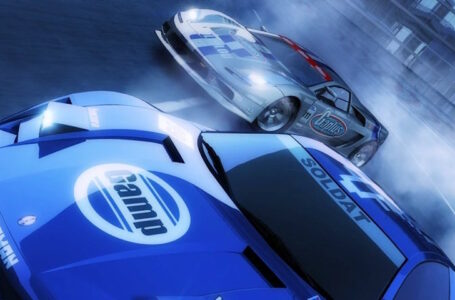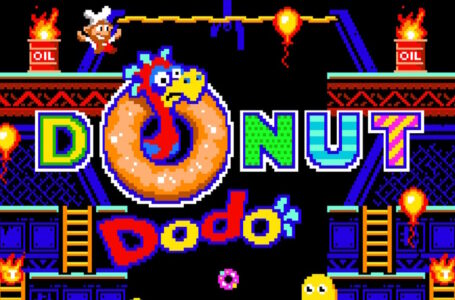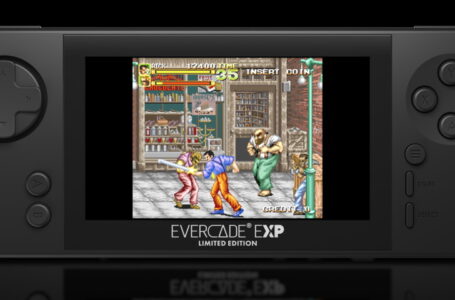2189: Graduating with badassery from Burning Force
According to the extensive lore of Namco’s UGSF Timeline, a lot of things started happening around the time that Cyber Commando’s events were unfolding. As well as it being a period of history that saw the construction of the space island colony Uranus and the establishment of the UGSF in its initial form, it also saw the establishment of the University of GAIA, an institution that is important to the setup for Burning Force, a game first released in 1989.
Burning Force’s events occur nearly a hundred years after the events of Cyber Commando, and the setup is nowhere near as dramatic or threatening to the wellbeing of society at large. Rather, we’re facing a simple academic examination: cosmonautics student and noted leotard enthusiast Hiromi Tengenji is facing her last test for the “Top of the Space” course at the University of GAIA, in the hope of joining the UGSF following her graduation.
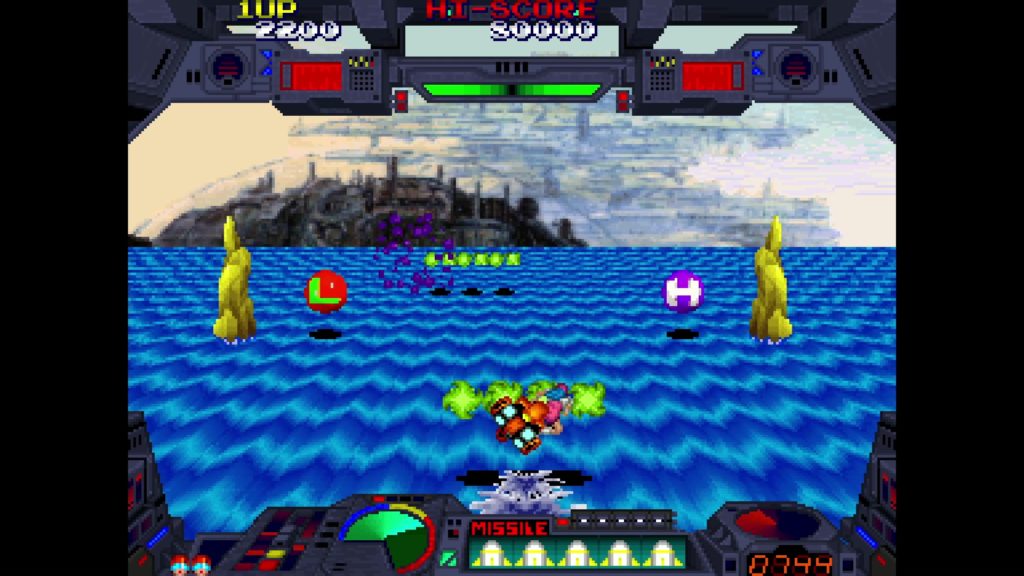
I lied a bit: this examination is anything but simple. Hiromi’s exam takes place over five days of continuous battle tests, and challenges her to pilot her airbike (apparently known as “SIGN DUCK”) and aircraft against a series of increasingly fearsome opponents. Survive those five days and she gets to test her skills in deep space; only by successfully passing this final test will she be able to realise her dream of joining the UGSF as a space pilot.
Spoilers: the ongoing UGSF timeline assumes that she was successful, and Hiromi later shows up as a guest character in the Japan-only Monolithsoft-developed tactical RPG Namco x Capcom (alongside her superior officer Kissy from Baraduke, who is actually from a couple of centuries after Hiromi’s time) following some interdimensional, time-travelling shenanigans.
To return to our own timeline, Burning Force began its life in our universe in 1989 as a Japan-exclusive arcade machine running on Namco’s System 2 hardware. This kit would also be seen powering a few of Namco’s lesser-known titles such as Cosmo Gang The Video (whose sequel would later become Pac-Attack), Dragon Spirit follow-up Dragon Saber, Phelios and Rolling Thunder 2.
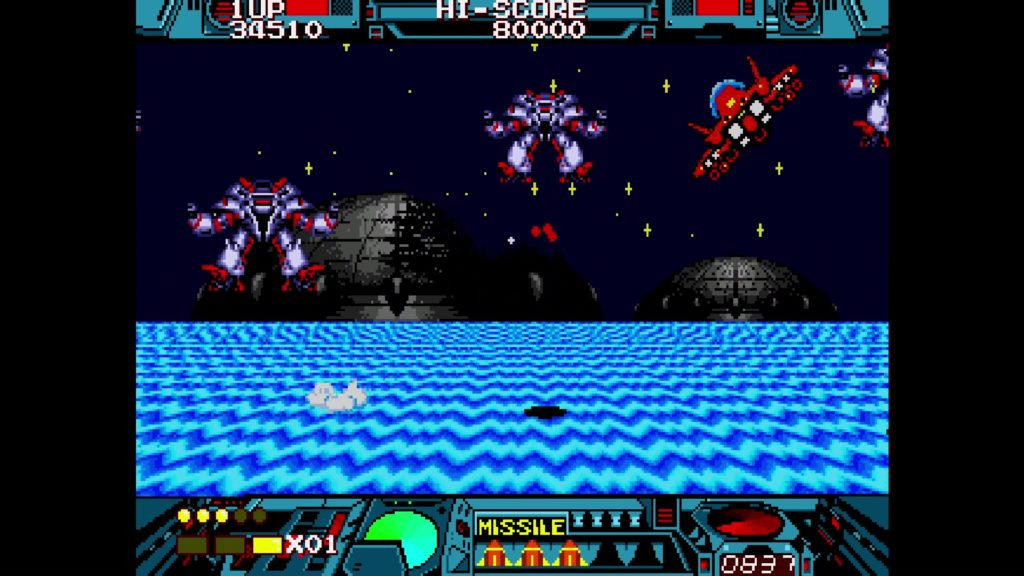
A year after Burning Force’s arcade release, it would get a port to Sega Mega Drive, and it’s here that it would become much more well-known due to its worldwide release. The Mega Drive version is also easily available today as part of the Namco Museum Collection 2 cartridge for the Evercade retro gaming platform, which once again helped to bring this excellent game to a whole new audience. (If you plan to pick up the Evercade cart, do note that Namco’s weird licensing stipulations mean that it will only work on the original Evercade handheld and upcoming EXP, not the TV-connected Evercade VS. No, we don’t know why either.)
Of the two versions, both are worth checking out, but the Mega Drive version is considerably more forgiving in numerous ways — more on that when we talk in more detail about the gameplay.
Burning Force is often described by lazy people as a clone of Sega’s classic Space Harrier, but although there are some superficial similarities, Burning Force is very much its own beast with its own distinctive handling. For starters, in the majority of levels you have no control over your altitude, since Hiromi is riding an airbike; instead of being able to move up and down, you instead have the ability to accelerate and brake.
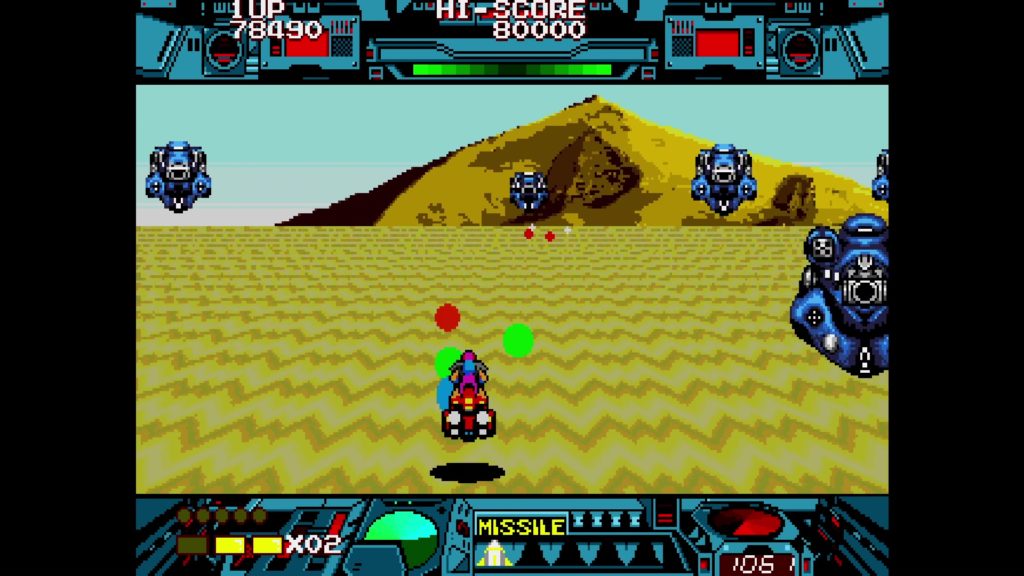
This means that the airbike levels in Burning Force actually unfold somewhat like a top-down vertically scrolling shooter that someone has pushed over and invited you to fly “into”. You move left and right, shooting enemies along the way, dodging bullets and collecting power-ups. And you do need to dodge those bullets; with no ability to change your altitude save for occasional jump pads on the course, you better get out of the way lest they slam into Hiromi and put her successful completion of the exam at risk.
In the arcade version, you need to be especially careful, since Hiromi can only take a single hit before losing a life, meaning that your game can be over quite quickly if you don’t play carefully. In the Mega Drive version, meanwhile, Namco generously added a hit points system to Hiromi, allowing her to take three direct hits (with a brief period of invincibility after each) before losing a life.
That’s not all, either; the Mega Drive version also introduces glowing green items which can be collected to add to a meter in the corner of the screen. Fill this up by nabbing five items and you can give Hiromi a limited period of invincibility — great for boss fights or particularly tough sections of level.
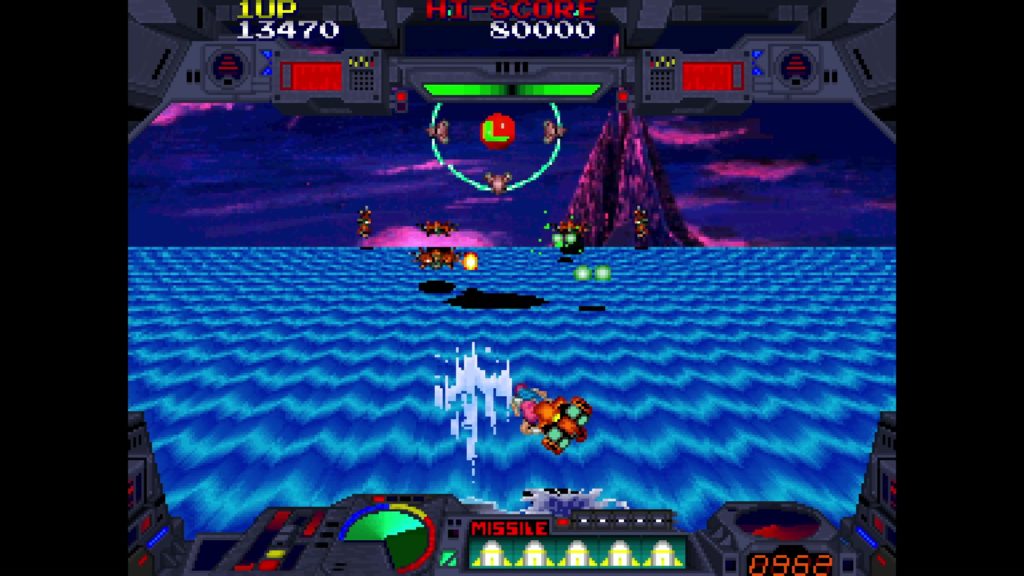
In both the arcade and Mega Drive versions, various power-ups are available to Hiromi. These are usually placed in awkward positions such as between environmental objects or floating in the air just after a jump pad, meaning you’ll have to learn the levels to be able to snag them reliably each time you play. Rather than being randomised as in some shoot ’em ups, the power-ups in Burning Force are always in the same place, so if you have a particular favourite weapon you’ll be able to prepare yourself for its appearance on subsequent playthroughs.
The three main upgrades to Hiromi’s basic weapon include a powerful piercing laser, a wide-ranging shot and a cross laser, which is something of a middle-ground between the two, offering a slight increase to both firepower and attack area, but not as much as the two more dedicated weapons.
Hiromi also has a complement of missiles attached to her vehicle, though she can only hold five at a time. Homing missiles are self-explanatory, while Max missiles act somewhat like a “bomb” in a 2D shoot ’em up; you fire it out and it blasts a wide area, dealing heavy damage to anything caught in the explosion.
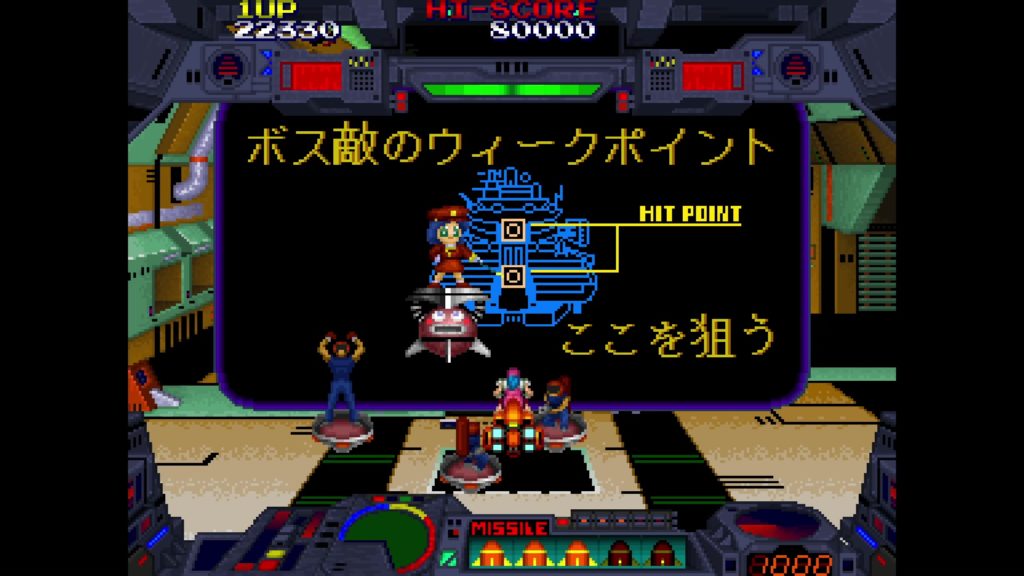
Burning Force has a predictable structure that you’ll quickly come to understand. The first two areas of an in-game day unfold with Hiromi piloting her airbike, and each concludes with a “powerful-but-not-quite-boss” enemy. Clear a stage and you get a bonus according to how much time you took.
The third area of each in-game day sees Hiromi dock with a supply ship and convert her airbike to an aircraft. During this process, she’ll be given a preview of the main boss ahead of her, plus its weak points. You’ll need to remember this for the confrontation ahead, since most bosses can’t be damaged at all outside of those weak points.
Once you launch from the supply ship, you can finally enjoy the benefits of changing your altitude. Not only can you now avoid bullets using a whole other axis of movement, but you can also grab power-ups that would be out of reach on the airbike. It changes up the feel of the game very nicely — and despite it more closely resembling Space Harrier during these sequences, still feels markedly distinct from Sega’s classic.
Blast your way through the day’s boss and you get a bit of a cooldown period in the fourth area, which simply challenges you to fly your aircraft while following a pathway of orbs that are worth points. In the Mega Drive version, this stage offers you the opportunity to earn extra lives, while in the arcade version the only extends you’re getting come from attaining high enough scores.
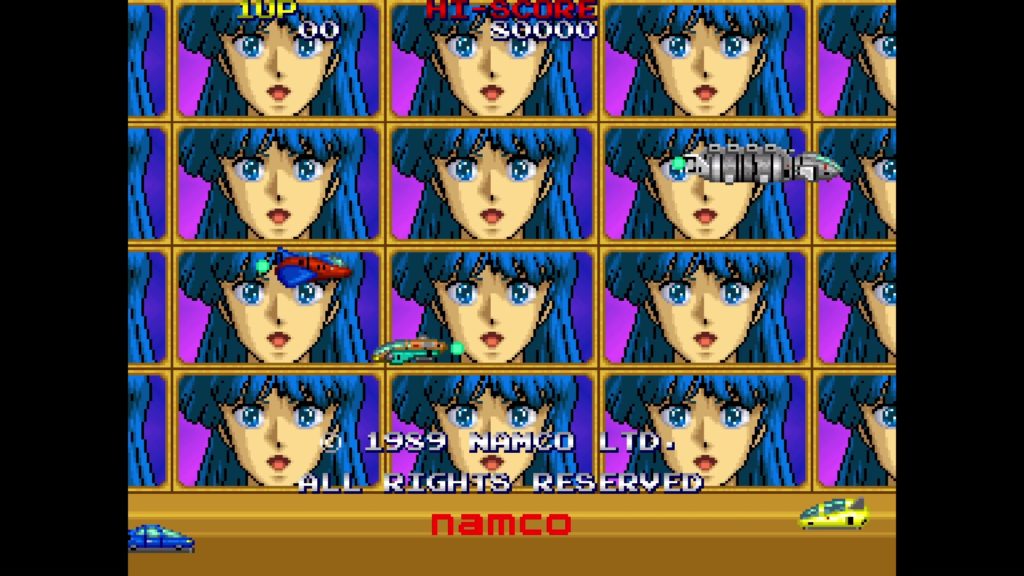
Burning Force is enormously enjoyable, regardless of which version you play — though the markedly increased difficulty of the arcade version can make it rather more frustrating! The Mega Drive version actually makes surprisingly few sacrifices in the name of bringing the game home, either; the main thing it lacks is the completely smooth sprite scaling of the arcade original, but a real effort has been made to provide all the in-game sprites with plenty of frames of animation to provide a rough approximation of the scaling effect. The appearance of the huge supply ship sprite at the start of each day’s third area is particularly impressive.
It’s also an incredibly stylish game. From the pop art-inspired attract mode to the vivid colours used throughout the entire game plus the lively, energetic and enormously catchy music, Burning Force is a game that really knows how to make an impression. It’s honestly quite surprising that it isn’t better-known than it is — though I suspect a big part of that comes from the fact that the original arcade version never made it out of Japan, meaning that anyone picking up the Mega Drive version in other regions would have done so with it being something of an unknown quantity.
That said, speak to anyone who owned a copy of or even just played Burning Force back in the day, and you’ll doubtless be on the receiving end of an enthusiastic diatribe about just what a marvellous, delightful, joyful and massively underappreciated cult classic this really is — and why you should find some means of playing it right now.
So go on, then. Get out of here. You’ve got Burning Force to play. And don’t stop until you can sing that stage 1 theme from memory.
Header art by ビィビィ/bb9_MegaDrive. Original source here.
Join The Discussion
Rice Digital Discord
Rice Digital Twitter
Rice Digital Facebook
Or write us a letter for the Rice Digital Friday Letters Page by clicking here!
Disclosure: Some links in this article may be affiliate links, which means we may earn a small commission if you make a purchase after clicking on them. This is at no additional cost to you and helps support Rice Digital!
- Letter from the Editor: passing the torch - June 30, 2023
- Super Woden GP 2 is looking promising - June 30, 2023
- Inti Creates is making a 32 bit-style Love Live action platformer - June 26, 2023





